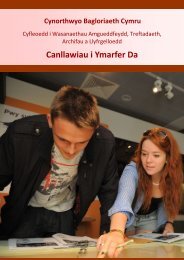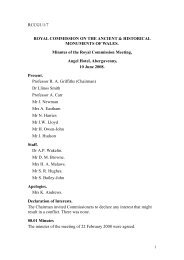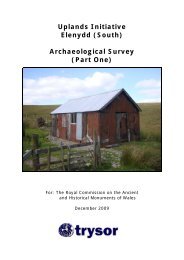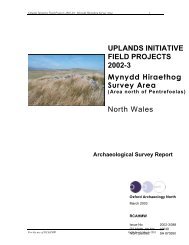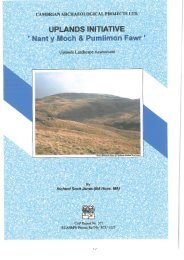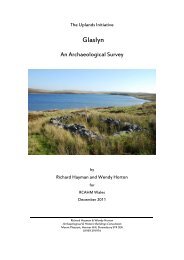Foel Goch Archaeological Survey - Royal Commission on the ...
Foel Goch Archaeological Survey - Royal Commission on the ...
Foel Goch Archaeological Survey - Royal Commission on the ...
Create successful ePaper yourself
Turn your PDF publications into a flip-book with our unique Google optimized e-Paper software.
Uplands Initiative Field Projects 2011-12: <str<strong>on</strong>g>Foel</str<strong>on</strong>g> <str<strong>on</strong>g>Goch</str<strong>on</strong>g> <str<strong>on</strong>g>Survey</str<strong>on</strong>g> Report 10<br />
cairn comprising, originally, four c<strong>on</strong>centric boulder rings set into a low cairn and a<br />
kerbed cairn circle (NMR 275897 and 400457; Lynch 1995, 61). In additi<strong>on</strong>, <strong>the</strong>re<br />
are also two round cairns located <strong>on</strong> Cefn Caer Euni recorded in <strong>the</strong> Gwynedd HER<br />
(NMR 519351 and 519349). Fur<strong>the</strong>r prehistoric sites are located nearby at Coed y<br />
Bedo farm (in <strong>the</strong> valley between <strong>the</strong> two porti<strong>on</strong>s of study area), which include <strong>the</strong><br />
Maen y Rhos standing st<strong>on</strong>e (NMR 303459: Scheduled ME 228), found in close<br />
proximity to a pair of burnt mounds (HER 2885).<br />
3.3.2 Ir<strong>on</strong> Age/Romano-British activity in <strong>the</strong> regi<strong>on</strong> seems to have had str<strong>on</strong>g defensive<br />
and military comp<strong>on</strong>ents, although most sites are fur<strong>the</strong>r to <strong>the</strong> south of <strong>the</strong> study<br />
area in <strong>the</strong> lowlands, mainly around <strong>the</strong> natural routeway in <strong>the</strong> valley c<strong>on</strong>taining<br />
Bala Lake (Cadw et al 1998, 69). There is little evidence from <strong>the</strong> HER of upland<br />
occupati<strong>on</strong> in <strong>the</strong> regi<strong>on</strong> immediately surrounding <strong>the</strong> present study area, although<br />
this may reflect a lack of archaeological investigati<strong>on</strong>. The route through <strong>the</strong> valley<br />
around Bala Lake has <strong>the</strong> potential to have been used as far back as <strong>the</strong> prehistoric<br />
period, prior to Roman occupati<strong>on</strong> (Bowen and Gresham 1967, 3). The study area<br />
c<strong>on</strong>tains a hillfort at Cefn Caer Euni located overlooking <strong>the</strong> valley to <strong>the</strong> north-east<br />
of Bala (NMR 93712; Lynch 1995, 83), and nearby <strong>the</strong>re is a single possible round<br />
house (NMR 519350). The distributi<strong>on</strong> of lowland findspots of st<strong>on</strong>e axes and axe<br />
hammers show a c<strong>on</strong>centrati<strong>on</strong> <strong>on</strong> <strong>the</strong> flanks of <strong>the</strong> hills located <strong>on</strong> <strong>the</strong> north side of<br />
Bala Lake (Cadw et al 1998, 40) which may point towards lowland occupati<strong>on</strong> in<br />
this area. There are Roman military complexes located at ei<strong>the</strong>r end of Bala Lake,<br />
which are joined by <strong>the</strong> putative Roman road to Chester (NMR 303524). There are<br />
<strong>the</strong> remains of an auxiliary fort at Caer Gai <strong>on</strong> <strong>the</strong> south-west end of <strong>the</strong> lake (NMR<br />
95436) and <strong>the</strong> cropmark remains of a large military complex at Llanfor <strong>on</strong> <strong>the</strong><br />
north-east end of <strong>the</strong> lake (NMR 95436). The complexes at Llanfor also revealed a<br />
putative destroyed st<strong>on</strong>e circle (Bowen and Gresham 1967, 283) and geophysical<br />
anomalies which may relate to putative Br<strong>on</strong>ze Age burial and ritual sites (Cadw et<br />
al 1998, 69). A fur<strong>the</strong>r round house site was recorded from <strong>the</strong> Gwynedd HER, but<br />
<strong>the</strong> present survey revealed that <strong>the</strong> structure at Moel Emoel (NMR 519305; Plate<br />
4), was more likely to be a later medieval or post-medieval stock management<br />
feature.<br />
3.3.3 Medieval: <strong>the</strong>re is <strong>on</strong>ly limited physical or documentary evidence for <strong>the</strong> dispersed<br />
upland habitati<strong>on</strong> and exploitati<strong>on</strong> in <strong>the</strong> study area in <strong>the</strong> medieval period, such as<br />
l<strong>on</strong>ghouses and/or o<strong>the</strong>r domestic structures and elements of field-systems, which<br />
are prevalent elsewhere in <strong>the</strong> regi<strong>on</strong> (OA North 2009; Davies 1973). A single oval<br />
enclosure <strong>on</strong> Cefn Caer Euni, recorded in <strong>the</strong> HER, was found during <strong>the</strong> present<br />
survey to be a well-preserved l<strong>on</strong>ghouse (NMR 519352). There is a tentative<br />
attributi<strong>on</strong> of <strong>the</strong> placename Eglwys Anne in <strong>the</strong> south-west of <strong>the</strong> study area as<br />
being <strong>the</strong> site of a medieval hermitage/church (NMR 43836; RCAHMW 1914 and<br />
1921), and <strong>the</strong>re is a dubious triangular platform adjacent to a spring which is<br />
supposedly <strong>the</strong> site of <strong>the</strong> building (Plate 5). A fur<strong>the</strong>r antiquarian site was recorded<br />
in 1698 by Edward Lhuyd, which was <strong>the</strong> findspot of a brass tripod pot or kettle <strong>on</strong><br />
Yr Orddu mountain (NMR 519290; RCAHMW 1914, 129). A putative cockpit was<br />
also recorded <strong>on</strong> <strong>the</strong> open fell just to <strong>the</strong> north of Coed y Bedo farm (NMR<br />
303458; Plate 6), and, nearby, was a possible farmstead within a small enclosure<br />
(NMR 519291). The farmstead of Coed y Bedo itself (just outside of <strong>the</strong> study area)<br />
is a Grade II Listed building (NMR 28290; LB – 4671) and is said (NMR entry) to<br />
have <strong>on</strong>ce been <strong>the</strong> home of <strong>the</strong> bard Bedo Aedderen around c 1500. The farmhouse<br />
For <strong>the</strong> use of RCAHMW © OA North: February 2012




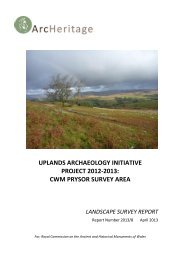
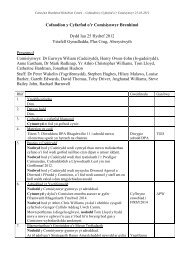
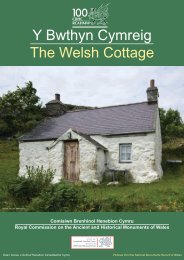

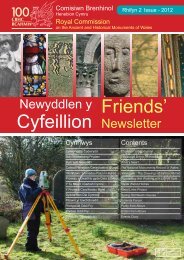
![The Source of the Usk Walk [2012 PDF]](https://img.yumpu.com/49285699/1/190x245/the-source-of-the-usk-walk-2012-pdf.jpg?quality=85)

